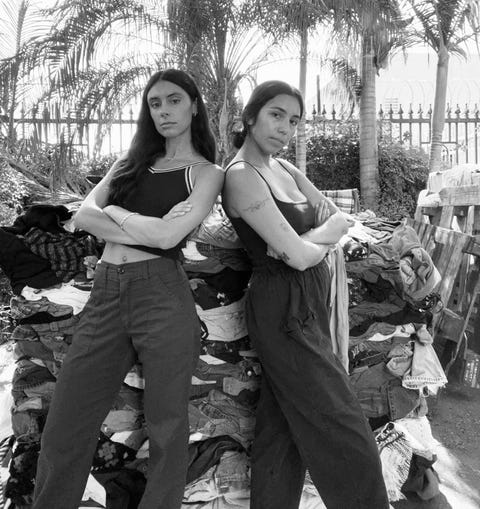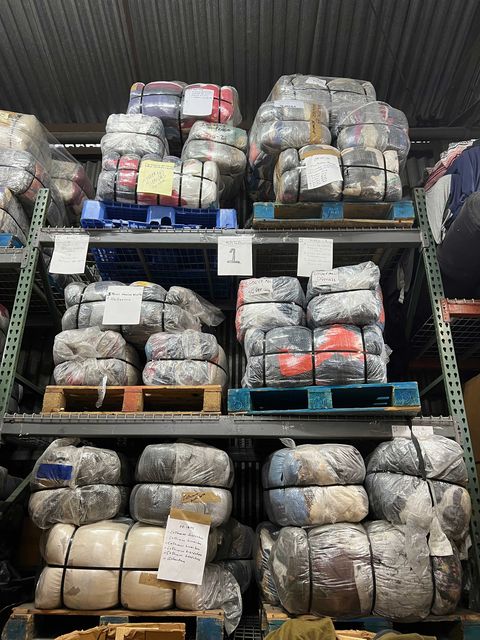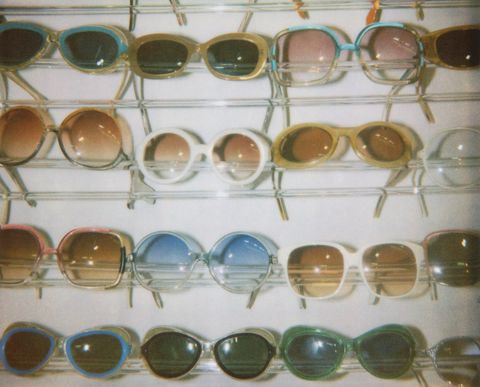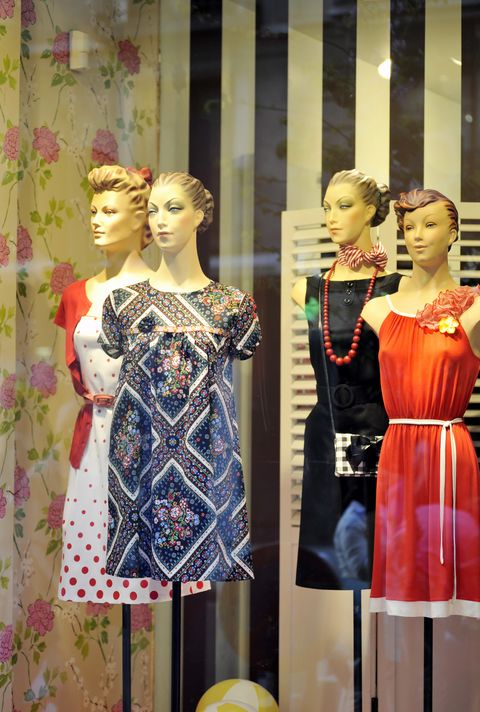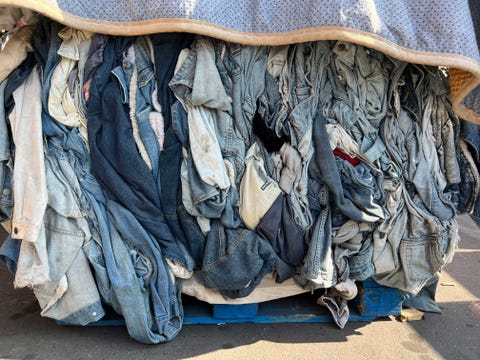Alicia Siemens shoves her arm back into the sagging sack of flannel and graphic T-shirts to pull a periwinkle something out of the stack. She holds it up against her chest to reveal a floral-print peasant dress circa 1970s. “There’s some staining,” she says, touching a yellowing lace collar, “But we should be able to do something with it.”
Siemens tosses the dress into a nearby shopping cart with about a dozen other items that she and co-worker Amanda Sanchez have set aside—a threadbare tee that reads “It’s Not Who You Are, It’s What You…WEAR,” a wrinkled cashmere cardigan, ’90s cargo pants. Behind her, dozens of six-foot-tall stacks of used clothing, wrapped tightly in tattered blankets and bound with wire, await release.
As a vintage buyer for Reformation, it’s Seimens’ job to scour public and private rag houses like this one for one-of-a-kind pieces. She visits several of the unmarked warehouses on the outskirts of Los Angeles each week, spending four to five hours wading through bales of miscellaneous clothing, sometimes sorted, sometimes not, usually dirty.
Most of the warehouses have no air conditioning or heating. Today, in the blazing mid-August heat, the stacks have been moved outside under a tarp. A manager checks in to see how she’s doing, while another warehouse employee uses a forklift to stack the bales. Every package is unlabeled—they don’t tell Siemens where they get their supply, and she doesn’t ask.
Between these private buying appointments, Siemens will make trips to thrift stores, shop friends’ vintage stores, or call up contacts with niche specialties—her denim guy, her sunglasses guy (Sanchez’s umber-tinted glasses are some of his: “Gucci, bay-bee!”).
Reformation resells almost everything its vintage buyers find. Some of it gets sold as “one-of-a-kind,” the brand’s word for true vintage, either online or at one of its dedicated vintage stores in Los Angeles, New York, or London. It also sells “upcycled styles”—items cut from existing garments that the vintage team alters into new pieces. Next is “remade,” where rolls of deadstock fabric are used to produce popular Reformation designs or vintage-inspired silhouettes. Occasionally, the team stumbles onto some bulk basics—a couple hundred tank tops or vintage sweatshirts—which it sells as a “deadstock batch.” Every single one of these items is hand-sourced by Reformation’s vintage buyers. They are a team of three.
Siemens pulls again from the pile—this time a threadbare graphic tee. “See, this is old.” She runs her fingers along the hem, pointing out its single stitch. The front features an armadillo on two legs, casually smoking a cigarette, and reads: “From Deep in the Heart of Texas.” “Just like me,” she says, and just like that, it’s in the cart.
Siemens and Sanchez move quickly, often without looking at the garments. They go by touch and feel, recognizing cashmere or cotton twill from muscle memory.
“Alicia is the textile queen,” says Sanchez.
“I can do denim without thinking,” Siemens says, “Tees slow you down, though. You have to stop and read them.”
It’s 10 a.m., and they’re already halfway through with their first bale. The goal is to get through at least three more to meet their monthly goals (while she won’t give hard numbers, Siemens tells me the Vintage team has “sales goals just like the rest of Ref—we’re just as business-oriented”), then get out before the temps hit the mid-90s.
The bale they’re picking through is “fresh,” meaning other buyers haven’t touched it. Once Siemens and Sanchez are finished, the rag house team will let additional clients, like smaller vintage stores and international buyers, have a go.
“We’ve been coming here for years, and we buy a lot, so they open the packs fresh for us and are always trying to learn about our business,” Siemens says. “Lately, they know we’re looking for more Y2K stuff. They keep teasing us, saying, ‘We’ve worked so hard for years to not take in this stuff!’ In this line of work, the better you build relationships, the better your business.”
Inside the warehouse, bales are stacked on industrial shelves up to the ceiling. One overflows with fur stoles. Siemens tells me there’s a second warehouse next door.
I’m struggling to grasp where it all comes from. Thrift store donations? If so, from L.A.? The rest of the country? Is it all used? And why is so much of it dirty?
Siemens, typically unflappable, gets edgy. “This is their business. They don’t like a lot of questions,” she says. I realize that a rag house employee hasn’t come within earshot since I arrived—when Siemens told them I was a writer.
Later, I connect with Elvia Lahman, creative director for American Recycled Clothing, or ARC, which Lahman describes as a “secondary” rag house versus a “true” rag house like the one I visited with Siemens and Sanchez in August. The distinction: ARC does some sorting and grading (“A: perfect condition. B: light stains or little holes but still fashiony. C: pit stains. Nobody wants these unless it’s an original 1970s Rolling Stones T-shirt,” says Lahman). In exchange, buyers pay a higher premium for whatever they find.
She laughs when I tell her I can’t get anyone to tell me how a rag house works. “Loosely, what it is is what it’s always been,” Lahman says, “Goodwill and Salvation Army get donations galore. When they have a surplus, they sell to rag houses.” These rag houses then sell what thrift stores don’t want for a profit. Until relatively recently, Lahman tells me that rag houses found their own supply—in dumpsters and gutters. “Rag houses used to do actual picking—imagine a truck going down the streets collecting rags—hence the name.”
Sometimes rags turn to gold. At the “true” rag house, I watch Siemens pull a woven and embroidered huipil dress from her pile. Maxi length, genuine vintage from Mexico, probably ’60s, perfect condition. Siemens tosses it in the “no” bin.
“It’s not our customer,” she says. “I feel okay nixing it, because whoever comes after us will grab it.”
“Alicia has a good one-liner for this,” Sanchez says.
“Good for the eyes, not for the buys,” Siemens says, reaching again into the mess.
It’s no secret that high-end vintage is having a moment. With the rise in demand for more sustainable fashion, the forever appeal of wearing one-of-a-kind pieces, and the convenience of Instagram Shop and Depop, almost anyone can start a vintage business—online, at least—for a few months. And many do.
In its 2022 Luxury Resale Report, The RealReal reported a 44 percent increase in items purchased on its platform. It also saw a surge in “flipping,” or customers buying an item, then selling it again a few months or weeks later. The vintage trend cycle is on pace with fast fashion.
The RealReal’s senior women’s fashion lead, Noelle Sciacca, credits Gen Z with the increase in buying and also selling. “They seem like they’re making it a business for themselves,” Sciacca told Fashionista late last month. “For their Instagram or TikTok moments, maybe wearing something and circling it back—they’re a bit more agile in that space.””
That vintage buying and reselling has become increasingly mainstream has caused concern among long-standing buyers. The current demand for secondhand often outstrips an intrinsically limited supply, leaving buyers—and even rag houses—scrambling to maintain their stock. Meanwhile, seasoned collectors find themselves in the same buying pool as hundreds of thousands of TikTok followers who have seen an influencer’s video about thrift hauls, DIY upcycling projects, or a rag house visit. And unlike professional vintage buyers, TikTok influencers often reveal their sources.
“Everything has changed,” says Richard Wainwright, the founder of A Current Affair, which brings together 200 vintage buyers for bicoastal and online trade shows. “When we launched 12 years ago, vintage was still very niche, and our approach of presenting a modern interpretation of vintage was revolutionary—it didn’t exist aside from a few highly specialized boutiques,” Wainwright says. “More and more people are wearing vintage, selling vintage, and sharing content around vintage, which has driven demand and driven prices up.”
Like any clothing after too many spin cycles, vintage also wears out. Pieces can only move through hands so many times. Many of the ’70s tees, old-school Levi’s 501s, and Art Deco gowns have disappeared from the resell cycle forever.
What survives is primarily preserved and sold by the luxury vintage giants, like a private archive, only shoppable. Think: What Goes Around Comes Around, which offers online shoppers a list of Top Picks Under $999, or Desert Vintage, which specializes in “turn of the century to 1960s” pieces—a Romeo Gigli silk organza blouse or a 1930s felted jacket—for anywhere from $500 to $1,000 or more.
Buyers are forced to get creative to find what remains. Alysha Cassis-Shaw, owner of Neutral Ground in Oakland, Calif., has begun traveling internationally two to three times per year. She recently returned from a trip across Portugal, then Paris, where she says her finds “weren’t inexpensive, but were unlike anything I could have sourced at home.”
“Now, when I’m sourcing, I’m not just competing against small businesses. I’m competing against corporations with far greater buying power,” Cassis-Shaw tells me. “They buy up huge lots of clothing to get the two good band T-shirts, or they scoop up all of the designer pieces at prices no small brand can afford. This means the quality of vintage the small brand owner can access has become much poorer. I now rely more heavily on estate sales or private clients. Or I do more restoration and repair to get garments to sellable condition.”
Cassis-Shaw also buys from other vintage resellers. “We are always collecting, even when those items don’t work for our particular brands,” she says. One vintage dress might cycle through multiple shops before it lands in a customer’s hands.
And multiple countries. Constance Freedman, the owner of the beloved Los Angeles vintage store Weepah Way says, “Every month, I had a team of buyers from Tokyo come through, and they always cleaned me out.”
In 2019, Freedman took a trip to Tokyo, stopping into some of her Japanese contacts’ stores to say hello and buy for Weepah. A few weeks later, the Japanese buyers visited her in L.A. “They bought everything I’d just brought back.”
Later by text, I ask Freedman if she thinks we’re heading toward a vintage extinction event. Are there too many vintage buyers working at too fast a clip, and are we about to run out of goods made well enough to survive?
The “typing” bubble flickers for only a second before she replies: “Yes and yes.”
ARC’s Lahman started as a vintage buyer for brands in 1989, working for American Rag, Urban Outfitters, and eventually as American Apparel’s vintage director. She then opened—and eventually closed—her own vintage store, The Loved One. Working for a rag house has allowed her to stay in the industry, minus the constant hunt for vintage.
These days, Lahman says she no longer calls anything vintage because there are no clear boundaries for what types of used clothing buyers—and their customers—want.
“The truth is, we get a lot of stuff from H&M and Zara, and when you take a label off, sometimes you have no idea,” she says. “It’s worth whatever your customer wants to pay. If the internet wants a pussy bow secretary blouse, and there’s a 2015 Zara copy of a ’70s or ’80s original, it’s going to sell.”
And while she’s noticed a marked increase in trend cycling and consumption, she’s not worried about an industry collapse.
“Being in the business for as long as I have, we always know there are ups and downs. Everyone’s fear in the ’80s and ’90s was: How long can this last?” she says. “And I mean, yes, a ’40s dress is not a dime a dozen anymore. But also, I remember a time when we didn’t want to say ’70s was vintage. It was just like, ‘Ew, no.’ To me, there’s no wrong or right way to do this. People are going to dress however they want, and they’re only going to get more loosey-goosey.”
Buying used clothing and accessories has long been presented as a more sustainable option for conscientious consumers. But, given the industry’s current competition, TikTok micro-trends, and general chaos, is that still the case?
Maxine Bédat is the director of the New Standard Institute, a think tank that uses peer-reviewed sources to provide guidance and policy recommendations on impact reduction in the fashion industry.
“There’s not a lot of data around [the rise in vintage consumption], but one report comes up in my mind. It was about paper use in bathrooms—I promise this is going to connect,” she says. “One time, they labeled the paper towels with a recycling sign, and another time they didn’t. When the recycling sign was included, the paper usage was considerably more. This is the moral hazard problem. What I worry about with TikTok and Depop and these other platforms is that people who engage with that space think, ‘Oh, I don’t have to think about my impact because I’m just engaging in the secondhand market.’”
As for upcycling as a sustainable practice, Bedat tells me that this depends mainly on the brand: “All of these things are good—vintage and deadstock—in theory. But we have to get in the weeds of what that looks like. I worry that deadstock fabric allows the industry to not think about their excess fabric because they get to ‘donate’ it in some sort of way. What are the unintended consequences of that?” she says. “It’s not to slam any of these companies. None of these things are straightforward. We’re clearly narrowing impact, but to what degree? Sometimes not at all, and oftentimes just marginally.”
In its last quarterly report, Reformation announced that 71 percent of its fabrics were made from recycled, regenerative, or renewable materials. That includes five percent deadstock materials sourced by its vintage team.
“Ref started as a vintage upcycling shop in L.A. in 2009,” says the brand’s chief sustainability officer, Kathleen Talbot. “We’ve always tried to protect our roots. It’s really the ethos of the brand: How do we use what already exists? We’ve tried to stay true to challenging the standard for sustainability and considering how to scale it in the right way.”
Beyond vintage and upcycling, Reformation does in-house recovery—damaged or returned items get cleaned, then either repaired or remade into new styles (Reformation then sells these items as one-offs in its sample sales). Talbot tells me the brand also has other, bigger upcycling initiatives in the works, at least in part thanks to the surge in vintage consumption.
“This is one of those times where consumer demands can really help brands and the climate. It’s a challenge we want to take on—to really listen to the customer and figure out how to scale that. We’re having fun with it.”
Small businesses are finding their own ways to meet demand and amplify their buying power and visibility. Community models have begun to appear, including A Current Affair’s trade shows and vintage co-ops like Seven Wonders Collective in Brooklyn, New York and Worship Vintage in Highland Park, L.A. Partnering, rather than competing, allows independent buyers to pool resources, reducing the hours they’re in-store and increasing the time they can spend hunting. Bonus: split rent. Then, there are high-end, limited- edition upcycled brands, like Town Clothes, and brands exploring the intersection of recycled fashion and activism, like Suay Sew Shop.
Bédat tells me that concerned consumers can treat this time as “an invitation to love your clothing” and extend the shelf-life of those clothes.
“None of this should be guilt-inducing,” she says, “If you love vintage fashion, that’s great. Invest in the vintage pieces that you know you’re going to wear over and over again. But if there’s one thing I’d like us to take away from this, it’s that we are citizens as much as we are consumers. If you care about these issues, there are ways to systemically change them.”
“We have to resist efforts by big businesses to greenwash their images and take over yet another segment of the market,” says Cassis-Shaw. “If you don’t have good vintage and secondhand resources in your community, seek out small, woman-owned and POC businesses online. These businesses often have the least buying power, and for most, it is a labor of love.”
That, in the end, is what vintage buying is—a calling that leads vintage buyers into the beating sun, pushes them through torn rotator cuffs and spiking wholesale costs, and keeps them coming back.
“The whole reason I’m still in this business is because I’m addicted. It’s the best way to be the maximalist that I am because I don’t have to feel bad. My whole home, everything I have, is used,” says Lahman. “I like the dust. I like when it’s hot. I am sweating. I am disgusting. I have lint in every little crease in my body. You can find a dead rat, a used condom. I love it all—the good, the bad, the ugly.”
Kit Warchol is a writer and editor living in Los Angeles.
